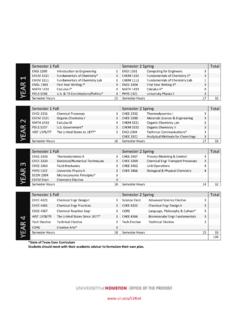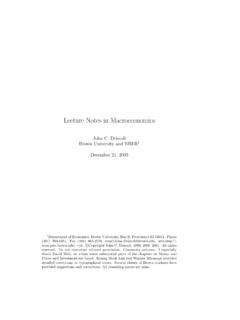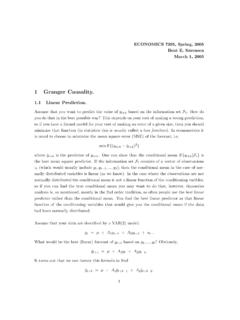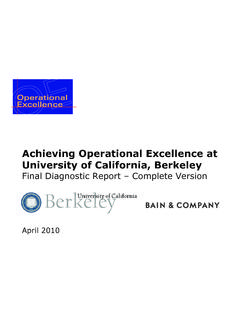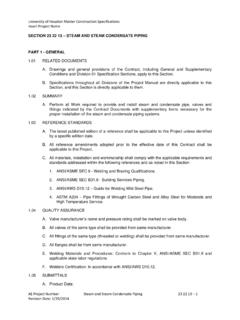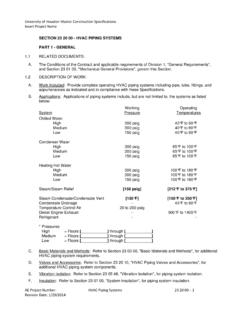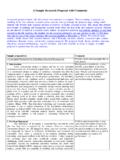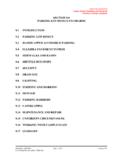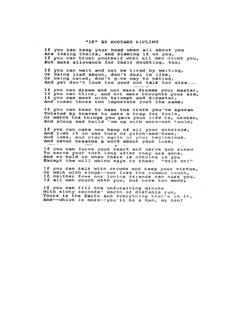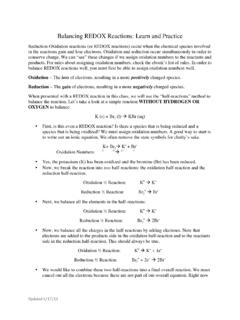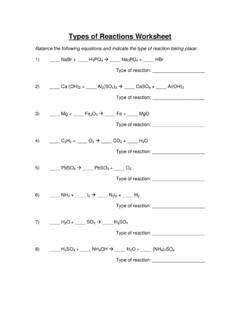Transcription of Chapter 3. Stoichiometry: Mole-Mass Relationships in ...
1 Chapter 3. stoichiometry : Mole-Mass Relationships in chemical Reactions1 The mole (or mol) represents a certain number of objects. SI def.: the amount of a substance that contains the same number of entities as there are atoms in 12 g of carbon-12. Exactly 12 g of carbon-12 contains x 10 23 atoms. One mole of H 2O molecules contains x 10 23 molecules. 1 mole contains x 10 23 entities (Avogadro s number)Concept 1. The meaning and usefulness of the mole2 One mole of NaCl contains x 10 23 NaCl formula units. Use the mole quantity to count formulas by weighing them. mass of a mole of particles = mass of 1 particle x x 1023 The mass of an atom in amu is numerically the same as the mass of one mole of atoms of the element in grams. One atom of sulfur has a mass of amu; one mole of S atoms has a mass of of 1 H atom: amu x x10-24 g/amu = x10-24 gMass of 1 mole of H atoms: x10-24g/H atom x x1023H atoms = gPT3 For compounds, the molecular mass (in amu) is numerically the same as the mass of one mole of the compound in grams.
2 Skill 3-1 Calculate the molecular mass of a compound as the sum of the atomic masses of its elements. Molecular mass H2O = (2 x atomic mass of H) + atomic mass of O = 2( amu) + amu = amu So, one mole of water ( x 10 23 molecules) has a mass of g. Molar mass of NaCl = atomic mass of Na ( amu) + the atomic mass of Cl ( amu) + = amu One mol of NaCl ( x1023 formulas) has a mass of 2. The relation between molecular (formula) massand molar mass4 To obtain one mole of copper atoms ( x 10 23 atoms), weigh out g copper. PT5 The molar mass (M) of a substance is the mass of one mole of entities (atoms, molecules, or formula units) of the substance. Molar mass has units of grams per mole (g/mol).Concept 3. The relations among amount of substance (in moles ), mass (in grams), and number of chemical entitiesSkill 3-2 mass - Mole Conversions6 Use the molar mass of an element or compound to convert a given number of moles to mass : We can do the reverse with 1/M, and convert any mass in grams to the number of moles : Use Avogadro s number to convert moles of substance to the number of entities:Problem: (a) How many grams of silver, Ag, are in mol Ag?
3 (b) How many atoms of Ag are in mol Ag?7 Plan: (a) To convert moles Ag to grams Ag, use the molar mass of Ag from the periodic table. (b) To convert moles to number of atoms, use Avogadro s number. Solution: (a) Converting from moles of Ag to mass :(b) Converting from moles of Ag to number of atoms:= x 1022 atoms AgPTProblem: Iron is a most important metal in our society. How many iron atoms are present in a piece of iron weighing g?8 Plan: Solution: Converting from mass of Fe to moles :Converting from moles of Fe to number of atoms:PT9 The sulfur dioxide formula, SO 2, shows that its molecules contain one S atom and two O atoms; calculate its molar mass . One mole SO 2 contains x 10 23 SO 2 molecules, which consist of x 1023 S atoms and 2( x 10 23) O atoms. Same for ionic compounds, such as potassium sulfide (K 2 S):Concept 4. The information in a chemical formula10 Problem: How many moles and formulas are in g ammonium carbonate? 11 Solution: Calculating molar mass :Skill 3-3 mass Percent and the chemical Formula12 The formula shows the number of moles of each element; use it to calculate the mass percent of each element on a mole basis:%Problem: The formula of the sugar glucose is C6 H12O6.
4 (a) What is the mass percent of each element in glucose? (b) How many grams of carbon are in g glucose?Plan: The formula gives the no. of moles of C, H and O in glucose. Convert from moles of element to grams using the molar mass . 13 Dividing by the mass of one mole of glucose gives the element s mass fraction; multiplying this fraction by 100% gives the mass (b) Determining the mass of : To find the mass of C in the glucose sample, multiply the mass of the sample by the mass fraction of C from part (a)Solution:15 If an unknown pure compound can be decomposed, the masses of elements present can be determined. Converting the masses to moles of elements leads to the empirical formula, the simplest whole-number ratio of moles of each element in the compound. Suppose a sample of unknown compound is found to contain mol zinc, mol phosphorus, and mol 5. The procedure for finding the empirical and molecular formulas of a compound A preliminary formula based on the data is Zn Convert the fractional subscripts to whole numbers.
5 :161. Divide each subscript by the smallest subscript:2. If any subscripts are still not integers, multiply through by the smallest integer that will turn all the subscripts into conventional way to write this formula is Zn 3 (PO 4 ) 2 ; the compound is zinc phosphate, a dental 3-4: Analysis of a sample of ionic compound gave: g Na, g Cl, and g O. What is the empirical formula and name of the compound?17 Plan:Solution: Find moles of elements:From the moles of each element, construct a preliminary formula and convert to integer formula:18 Convert to integer subscripts: Note that we rounded the subscript of O from to 4. The empirical formula is NaClO 4 ; the name is sodium Formulas19 The actual number of moles of each element in the smallest unit of the compound. In water (H 2O), ammonia (NH 3), methane (CH 4), and ionic compounds, the empirical and molecular formulas are identical. In some cases the molecular formula is a whole-number multiple of the empirical formula.
6 Using the empirical formula to obtain the molecular peroxide has the empirical formula HO ( )Dividing its molar mass ( g/mol) by the empirical formula mass gives the whole-number multiple: The molecular formula is H 2O2 . Skill 3-5 : Lactic acid (M = g/mol) contains mass % C, mass % H, and mass % O. (a) Determine the empirical formula of lactic acid. (b) Determine the molecular : Assume 100 g lactic acid to express each mass % as grams. Convert grams to moles and find the empirical : Express mass % as grams; assume 100 g lactic acid:Similarly, there are g H and g O. Converting from grams of elements to moles :Determining the molecular formula: Plan: Divide the molar mass by the empirical formula :21 Similarly, we have mol H and mol the preliminary formula:Converting to integer subscripts:Calculate the molecular formula:Combustion Analysis22 Combustion analysis gives the amounts of carbon and hydrogen in a sample of combustible compound. The C forms CO 2 , which is absorbed in the first chamber.
7 The H forms H 2O, which is absorbed in the second chamber. Weigh the chambers before and after combustion. Calculate the masses of CO 2 and H 2O Use them to calculate the masses of C and H in the compound. From the masses, calculate the empirical formula. Skill 3-5 contd: Vitamin C (M= 176. g/mol) contains C, H and O. A g sample was placed in a combustion apparatus:Plan: -Use changes in mass of CO 2 and H 2O absorbers to calculate the moles of C and H present in the sample. -Find the mass of C, using the mass fraction of C in CO 2 . Likewise, find the mass of H from the mass of H2O. -The mass of vitamin C minus the sum of the C and H masses gives the mass of O. -Construct the empirical formula and molecular is the molecular formula of vitamin C?Solution: Finding the masses of combustion products:24 Calculating mass fractions of the elements:Calculate masses of C and H:25 Find the moles of elements: Divide mass of each by its molar mass gives mol C, mol H, and mol O.
8 Construct the preliminary formula:Calculate mass of O by difference:Divide through by the smallest subscript:26 Determine the empirical formula. By inspection, find that 3 is the smallest multiple that makes all subscripts into integers:Determine the molecular formula: chemical Formulas and the Structures of Molecules27 Can be different compounds or structural isomers of the same compound (same molecular formulas). chemical formulas represent real three-dimensional objects. The molecular formula tells the number of each type of atom. Molecular formulas may not be unique; the same types and numbers of atoms can bond to each other in more than one way28 Structural Formulas Consider C2H 6O; two very different compounds have this molecular formula:-ethanol, the intoxicating substance present in wine and beer -dimethyl ether, a colorless gas once used in refrigeration Their radically different physical and chemical behaviors are the result of different molecular ether29 For an equation to depict accurately the amounts of chemicals involved in a reaction, it must be balanced.
9 The same number of each type of atom must appear on both sides of the equation. In a flashbulb Mg wire and oxygen gas react to yield magnesium oxide 6. The importance of balancing equations for the quantitative study of chemical reactionsTranslate the chemical statement into a skeleton equation: chemical formulas arranged in an equation yield productsBalancing the atoms Each blank must contain a balancing coefficient, a numerical multiplier of all the atoms in the formula that follows it. Stepwise, match the atoms on each side, element by element, beginning with the most complex one Mg on the one oxygen on the the coefficients. The smallest whole-number coefficients are required. To remove the 1/2 O2, multiply the whole equation by 2: A coefficient of 1 is implied by the presence of the substance and is not written: Check the numbers of atoms:Reaction equation is the states of matter. A complete equation shows the physical state of each substance or whether it is dissolved in water.
10 Solid (s) liquid (l) gas (g) aqueous solution (aq)33 From the statement, Mg wire is solid, O 2 is a gas, and powdery MgO is a solid:2Mg(s) + O2(g) 2 MgO(s)Skill 3-6: Octane (C8 H 18) burns to form carbon dioxide and water vapor. Write a balanced equation for this reaction. 34 Balance the atoms. Start with the more complex reactant, C 8H 18 , then balance O 2:8 C on left requires 8 CO2 on right:Solution: Translate the statement into a skeleton equation (with coefficient blanks). Octane and oxygen are reactants; oxygen is molecular O 2 . Carbon dioxide and water vapor are products:18 H on left requires 9 O on right requires 25/2 O2 Adjust that the equation is balanced: reactants (16 C, 36 H, 50 O) = products (16 C, 36 H, 50 O)States of matter: C 8H 18 is liquid; O 2 , CO 2 , and H 2O vapor are gases:36 A balanced equation relates quantities of atoms, molecules, formula units, moles of substance, and 7 The Mole-Mass -number information contained in a balanced equation37 Quantitative Relationships in a balanced equation are expressed as stoichiometrically equivalent molar ratios.
